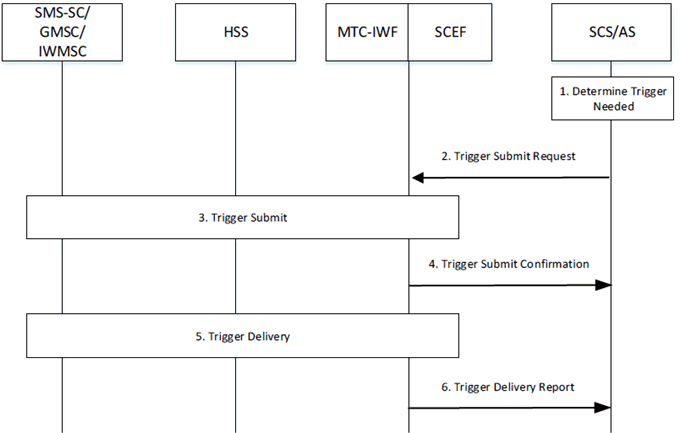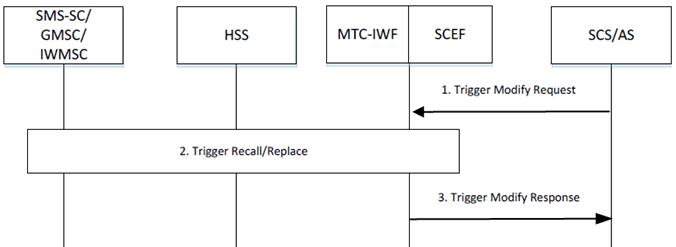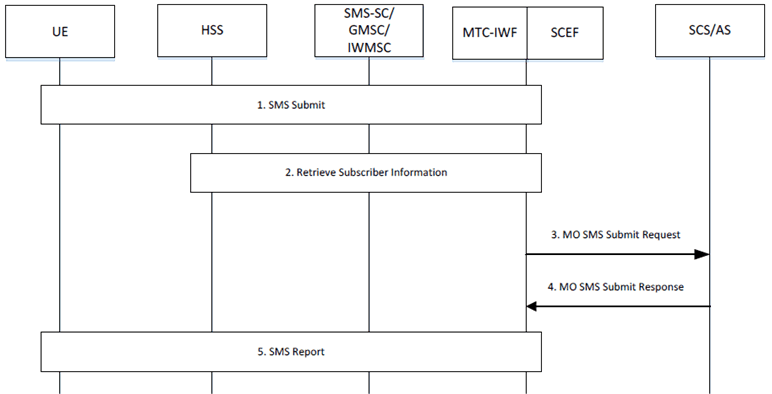Content for TS 23.682 Word version: 18.0.0
1…
4.2
4.3…
4.4…
4.5…
4.5.7…
4.5.14…
4.6…
5…
5.3…
5.5…
5.6…
5.6.2…
5.6.6…
5.7…
5.8…
5.9…
5.13…
5.14…
5.15
5.16
5.17…
5.18
5.19…
A…
C…
5.17 Procedures for accessing MTC-IWF Functionality via SCEF
5.17.1 Device triggering procedure via T8
5.17.2 Device triggering recall/replace procedures via T8
5.17.3 Procedure for MSISDN-less MO-SMS via T8
...
...
5.17 Procedures for accessing MTC-IWF Functionality via SCEF |R15| p. 118
5.17.1 Device triggering procedure via T8 p. 118
Figure 5.17.1-1 shows the procedure for Triggering via T8.

Step 1.
The SCS/AS determines the need to trigger the device. If the SCS/AS has no contact details for the SCEF, it may determine the IP address(es)/port(s) of the SCEF by performing a DNS query using the External Identifier or using a locally configured SCEF identifier.
Step 2.
The SCS/AS sends the Trigger Submit Request (External Identifier or MSISDN, SCS Identifier, trigger reference number, validity period, priority, Application Port ID and trigger payload) message to the SCEF. The SCEF assigns a TLTRI to the Trigger Submit Request.
Step 3.
The SCEF/MTC-IWF executes steps 3-6 of the Device triggering over Tsp procedure of clause 5.2.1, followed by steps 1-2 of the Trigger Delivery using T4 procedure of clause 5.2.2.
Step 4.
The SCEF sends a Trigger Submit Confirmation (TLTRI, Cause) to the SCS/AS to confirm that the Device Trigger Request has been accepted for delivery to the UE.
Step 5.
Steps 4-9 of the Trigger Delivery using T4 procedure of clause 5.2.2 are executed. In step 9 of the Trigger Delivery using T4 procedure, the SCEF/MTC-IWF receives the Message Delivery Report from the SMS/SC.
Step 6.
The SCEF sends the Trigger Delivery Report (TLTRI, cause) message to the SCS/AS with a cause value indicating the trigger delivery outcome (e.g. succeeded, unknown or failed and the reason for the failure).
5.17.2 Device triggering recall/replace procedures via T8 p. 119
Figure 5.17.2-1 shows the procedures for recalling and replacing triggers over T8.

Step 1.
The SCS/AS determines that it needs to recall/replace a trigger message that it has previously submitted. The SCS/AS sends Trigger Modify Request (SCS Identifier, TLTRI, action type, new trigger reference number, new validity period, new priority, new Application Port ID, and new trigger payload) message with action type set to "Trigger Recall Request" or "Trigger Replace Request". The SCS needs to include a new trigger reference number, new validity period, new priority, new Application Port ID and new trigger payload for trigger replace request only. The SCEF uses the TLTRI to determine the trigger reference number which was assigned to the previously submitted trigger message that the SCS/AS wants to cancel.
Step 2.
The SCEF/MTC-IWF executes steps 2-4 of the Device trigger recall/replace procedure over Tsp of clause 5.2.3.1.
Step 3.
The SCEF indicates trigger recall/replace success or failure in the Trigger Modify Response (result) message to the SCS/AS.
5.17.3 Procedure for MSISDN-less MO-SMS via T8 p. 120
Figure 5.17.3-1 shows the procedures for MSISDN-less MO-SMS via T8.

Step 1.
The UE sends an SMS to the SCS/AS. The UE, MSC/MME/SGSN, and SMS-SC execute steps 1 and 2 of the MSISDN-less MO-SMS via T4 procedure of clause 5.15. SMS-SC uses the destination SME address (long/short code of the SCS/AS) to identify the corresponding SCEF based on a pre-configured mapping table. SMS-SC extracts the SMS payload, Application port ID, and IMSI of the UE and deliver them to SCEF via T4 along with the destination SME address (long/short code of the SCS/AS).
Step 2.
The SCEF/MTC-IWF executes steps 4-5 of the MSISDN-less MO-SMS via T4 procedure of clause 5.15.
Step 3.
The SCEF sends a MO SMS Submit Request (SMS payload, external ID, and Application Port ID) to the SCS/AS. The SCS/AS is identified with the destination SME address (long/short code of the SCS/AS) received from step 1. The payload is delivered directly to the SCS/AS, it is not processed by SCEF.
Step 4.
The SCS/AS sends a MO SMS Submit Response to the SCEF.
Step 5.
The SCEF/MTC-IWF executes steps 7 of the MSISDN-less MO-SMS via T4 procedure of clause 5.15. The SMS Delivery or failure report is delivered to the UE as shown in step 8 of the MSISDN-less MO-SMS via T4 procedure of clause 5.15.